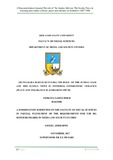Please use this identifier to cite or link to this item:
https://cris.library.msu.ac.zw//handle/11408/4007Full metadata record
| DC Field | Value | Language |
|---|---|---|
| dc.contributor.author | Tsokota, Gamuchirai | - |
| dc.date.accessioned | 2020-12-09T09:10:52Z | - |
| dc.date.available | 2020-12-09T09:10:52Z | - |
| dc.date.issued | 2017-11 | - |
| dc.identifier.uri | http://hdl.handle.net/11408/4007 | - |
| dc.description.abstract | This dissertation is an exploration of the controversy on media silence on interethnic discourses in the media of Zimbabwe. It draws its case study to the years immediately after the signing of the Unity Accord 1987 with the assumption that the media of that time was most likely to report discourses of inter-ethnic discourses as it was the period of national healing. It analyses two weekly newspapers under the Zimpapers stable The Sunday Mail and The Sunday News .Kunyarara hakusi kutaura is a term derived from the book by the famous Zimbabwean author Charles Mungoshi with the argument that silent is part of communication. Media texts should be analysed not only from the text that is provided but also from that which is absent. This study acknowledges that there is a body of literature on gukurahundi and unity however, this study is unique as it dwells more on the role of the media after the ethnic violence and analyses the discourse that emerged and the use of silence in the frame. This research hypothesised a theory towards the use of silences in the media drawing from theories and sketch theories in order to inform the study. The study applies qualitative methods for research, archival collections and interviews were used to collect data. The data collected was then purposively sampled. A critical political economy of the Zimpapers organisation was carried out as the two newspapers under study are under its stable hence the relationship between the organisation and content was important to evaluate. A critical discourse analyses was used to draw out finding which were then thematically presented. The study found out that the two newspapers used silence as a technique to repress inter-ethnic differences while at the same time agitating for peace and tolerance through the lenses of national and political peace. Silence was also used to propagate ZANU PF hegemony. | en_US |
| dc.language.iso | en | en_US |
| dc.publisher | Midlands State University | en_US |
| dc.subject | inter-ethnic peace | en_US |
| dc.subject | tolerance | en_US |
| dc.subject | media | en_US |
| dc.title | [ Kunyarara hakusi kutaura] The role of The Sunday Mail and The Sunday News in fostering inter-ethnic peace and tolerance in Zimbabwe 1987-1990. | en_US |
| dc.type | Thesis | en_US |
| item.fulltext | With Fulltext | - |
| item.languageiso639-1 | en | - |
| item.openairetype | Thesis | - |
| item.grantfulltext | open | - |
| item.openairecristype | http://purl.org/coar/resource_type/c_18cf | - |
| item.cerifentitytype | Publications | - |
| Appears in Collections: | Bsc Media And Society Studies Honours Degree | |
Files in This Item:
| File | Description | Size | Format | |
|---|---|---|---|---|
| GAMUE FIRST DRAFT.pdf | Full Text | 2.12 MB | Adobe PDF |  View/Open |
Page view(s)
220
checked on Apr 17, 2025
Download(s)
176
checked on Apr 17, 2025
Google ScholarTM
Check
Items in MSUIR are protected by copyright, with all rights reserved, unless otherwise indicated.



